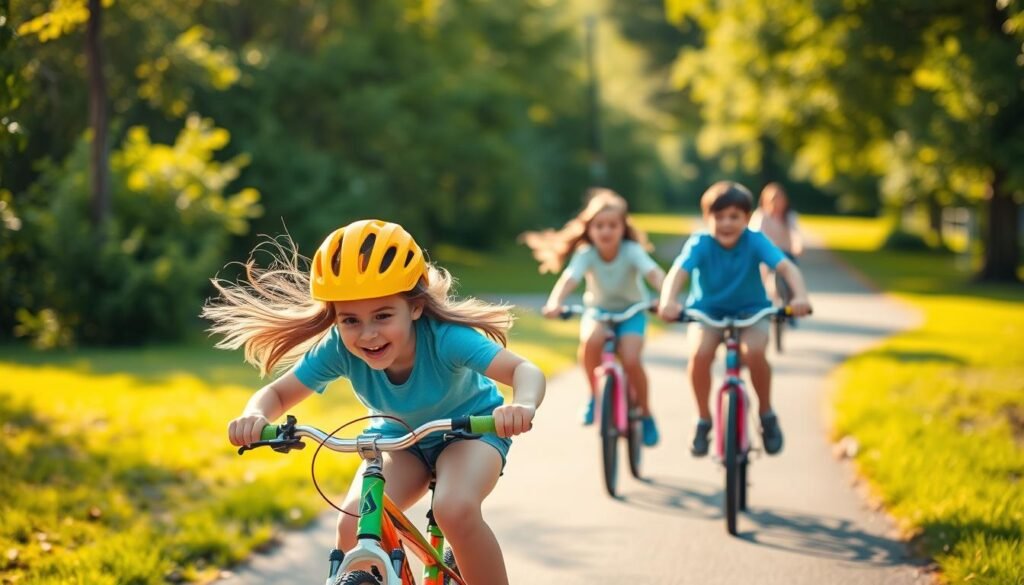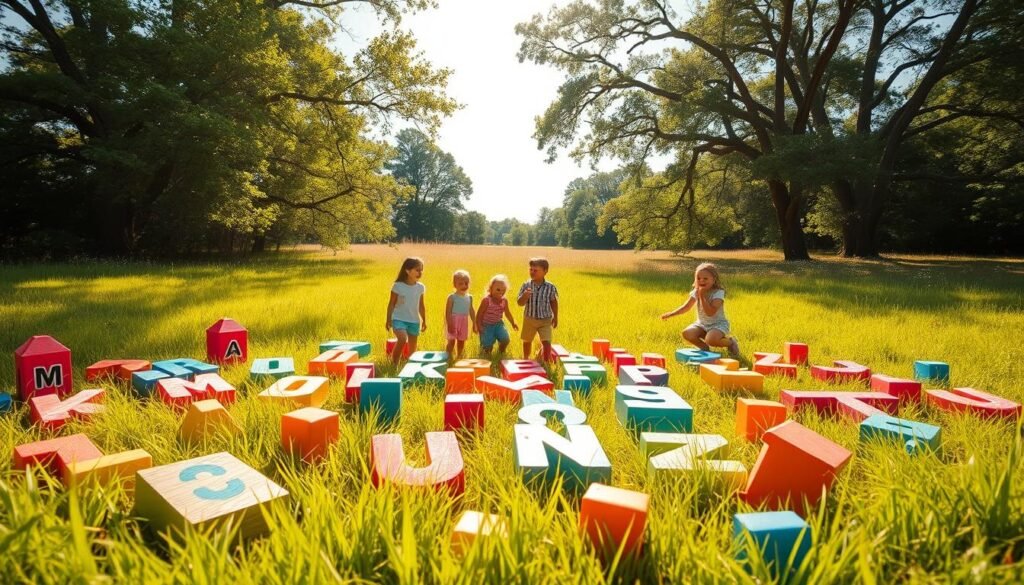Ever wondered how to turn a simple afternoon outside into an unforgettable adventure for your little ones? Nature offers endless opportunities for play, learning, and growth—no fancy equipment needed.
From scavenger hunts to backyard obstacle courses, these engaging ideas spark creativity while boosting motor skills and sensory development. Warmer weather makes it the perfect time to explore, whether it’s Earth Day or just a sunny weekend.
Parents can also track milestones with tools like the Pathways.org Baby Milestones app. Ready to make memories while soaking up the sunshine?
Key Takeaways
- Encourages sensory stimulation and physical development
- Simple, low-prep ideas using natural elements
- Perfect for seasonal celebrations or everyday play
- Strengthens family bonds through shared adventures
- Supports skill-building in a fun, unstructured way
1. Go for a Nature Walk
Exploring the outdoors with kids builds curiosity and connection with the natural world. Whether in a backyard or a nearby trail, every step offers chances to discover textures, colors, and sounds.
What to Look For
Encourage kids to touch rough tree bark or smooth stones. Compare crunchy leaves to soft moss. Point out seasonal changes like blooming flowers or animal tracks.
Turn the walk into a game by counting pinecones or naming insects. Ask questions like, “How many shades of green are in these leaves?” to spark observation skills.
Benefits for Kids
Nature walks boost a child’s sensory and communication development. Describing findings aloud builds vocabulary, while balancing on logs improves coordination.
These simple adventures also teach patience and appreciation for the environment. Plus, they’re a great way to unwind without screens.
2. Create a Mini-Garden
Digging into dirt and planting seeds can turn any backyard into a lively classroom for young explorers. A mini-garden teaches responsibility while letting kids witness nature’s magic up close.
Choosing the Right Plants
Pick fast-growing, hardy plants like sunflowers or cherry tomatoes. Bright flowers like marigolds add pops of color, while herbs like mint engage the senses with their smell.
Involve kids in selecting seeds—it’s a great way to spark excitement. Label each plant with painted rocks for a creative touch.
Gardening Tips for Kids
Keep tools child-sized and tasks simple. Assign watering duties with a small jug, and show them how to check soil moisture.
Turn weeding into a scavenger hunt by spotting specific leaves. Celebrate tiny victories, like the first sprout, to build confidence.
How to Set It Up
Use raised beds or containers if space is limited. Line the area with kid-friendly mulch to minimize mess.
Add a magnifying glass for inspecting bugs and soil. Laminate plant care charts for rainy-day reviews.
Items to Include
Gather these things for a fun start:
- Small shovel and gloves
- Seed packets (choose vibrant varieties)
- Watering can with a narrow spout
- DIY plant markers
- Journal to track growth
Pair gardening with other activities, like sketching plants or measuring their height weekly.
4. Play in the Sand
Sandboxes aren’t just for castles—they’re secret classrooms where kids develop key abilities. Whether at the beach or a backyard pit, shaping and sifting sand boosts creativity and sensory awareness.

Sand Play Ideas
Turn a sandbox into an adventure zone. Build imaginary cities with moats or hide small toys for excavation missions. Compare how wet and dry sand holds shapes differently.
Use sticks to practice writing letters or numbers. Scooping and pouring water strengthens grip, while burying feet enhances proprioception (body awareness).
Developmental Benefits
Sand play builds fine motor skills and hand-eye coordination. Describing textures and actions—like “gritty” or “packed”—expands vocabulary.
It’s also a great way to introduce early science concepts. Kids learn cause-and-effect by testing how towers collapse or water flows.
Add natural items like rocks or shells to decorate creations. This blends art with tactile exploration.
5. Try an Outdoor Craft
Unleash creativity under the open sky with hands-on projects that blend art and nature. These fun outdoor crafts turn any space into an art studio while keeping cleanup simple.
Rock Painting
Transform ordinary stones into treasures with washable paint. Kids love decorating smooth rocks with bright colors, then hiding them for others to find.
Host a painting party with neighbors to build community connections. Add inspirational words to create gratitude rocks that spread joy. For durability, seal finished pieces with clear spray.
Sidewalk Chalk Art
Sidewalk chalk turns pavement into a giant canvas. Design hopscotch grids with math problems in each square for learning through play.
Create movement-based obstacle courses with prompts like “spin here” or “jump high.” For a science twist, mix crushed chalk with water to make nature-based paint.
This activity encourages gross motor development while letting imaginations run wild. Temporary masterpieces wash away, ready for new creations tomorrow.
6. Practice Mindfulness Outdoors
Nature’s calm becomes a powerful tool when teaching kids mindfulness through simple outdoor moments. The rustle of leaves or the scent of blooming flowers can anchor their attention, turning a backyard into a peaceful retreat.
Simple Mindfulness Exercises
Start with a five senses scavenger hunt. Ask kids to name one thing they hear, smell, and touch—like bird songs, grass textures, or floral scents. This way, they learn to observe details mindfully.
Cloud-gazing adds storytelling. Lie in a grassy area and describe shapes in the sky. Pair deep breaths with nature sounds, like wind or flowing water, to teach calming skills.
Benefits of Outdoor Mindfulness
Creating mandalas with twigs or pebbles blends creativity with focus. Discussing how nature makes them feel builds emotional awareness—a key part of family fun.
These activities sharpen attention spans and reduce stress. Kids gain patience while connecting with their surroundings in meaningful ways.
7. Go for a Bike Ride
Pedaling through the neighborhood isn’t just exercise—it’s a gateway to adventure for young riders. This activity strengthens coordination while turning sidewalks into discovery zones.

Safety First
Always prioritize helmets and bright clothing. Teach hand signals using color-coded cards to make learning fun.
Start with quiet streets or empty parking lots. Practice braking and turning before tackling longer routes.
Kid-Friendly Routes
Flat, paved trails at a local park are perfect for beginners. Rail-trail conversions offer scenic rides with minimal hills.
Map neighborhood loops with rest stops at landmarks. For toddlers, balance bikes build confidence before transitioning to pedals.
Organize family time trials with stopwatches—a great way to mix fun and fitness. Many parks even offer bike rentals for hassle-free outings.
8. Visit a Park
From open fields to shaded trails, parks offer diverse landscapes for kids to discover. These green spaces combine play and learning, making them ideal for family fun and outdoor activities that engage all ages.
Activities to Try
Pack a picnic near a kite-flying zone where breezes lift colorful creations skyward. Many parks designate open areas perfect for tossing frisbees or playing tag. Check seasonal event calendars for outdoor concerts that turn lawns into dance floors.
Turn exploration into games with navigation challenges using park maps. Look for trails with native plant signs to blend education with adventure.
Choosing the Right Park
Compare playgrounds with varied equipment—some feature climbing walls, while others have musical instruments. In summer, prioritize parks with splash pads for cooling off. Seek locations with shaded pavilions for snack breaks.
Smaller neighborhood parks often host less crowds, while larger ones may offer rental bikes or paddleboats. Always check restroom availability when planning longer visits.
9. Try Out Different Sports
Sports ignite excitement and teamwork in young minds while building essential physical abilities. Simple equipment like foam soccer balls or plastic bats lets kids explore safely. Adapting rules keeps the focus on fun, not competition.
Kid-Friendly Sports
Start with tee-ball for young players—adjust bases closer for shorter legs. Pool noodles double as safe “swords” for imaginative play. Disc golf introduces aiming skills with lightweight frisbees.
Host a family Olympics with relay races and obstacle courses. Use hula hoops as targets for beanbag tosses. These games build coordination without pressure.
Equipment Needed
Child-sized basketball hoops and soft dodgeballs reduce frustration. Foam balls are perfect for backyard soccer or volleyball. A mix of textures—like rubbery kickballs—adds sensory variety.
Label bins with pictures for easy cleanup. Laminate rule sheets for rainy-day reviews. Encourage kids to try different sports monthly to discover favorites.
10. Build a Bird Feeder
Watching birds flutter and feast in your backyard brings nature’s wonders right to your doorstep. This simple project combines creativity with science, letting kids observe wildlife up close.
Materials Required
Gather natural things like pinecones, peanut butter, and birdseed. Add a string for hanging and recycled cardboard for seed trays. For variety, mix in sunflower seeds or dried fruit chunks.
How to Hang It
Choose a quiet way to suspend the feeder—near a window or tree branch works best. Secure it at eye level for easy viewing. Avoid windy spots to keep seeds from scattering.

Kids love tracking visitors with DIY binoculars made from toilet paper tubes. Compare which birds prefer seeds versus suet balls. Turn it into a daily activity by logging sightings on a tally sheet.
Discuss migration patterns when chickadees or sparrows stop by. This hands-on project blends art, biology, and patience into one engaging experience.
11. Color Scavenger Hunt
Turn your backyard into a vibrant classroom with a rainbow-inspired search game. This activity sharpens observation skills while celebrating nature’s diverse hues. All you need are clothespins, paint swatches, and a sense of adventure.
Setting Up the Hunt
Clip paint samples to a board and challenge kids to find matching colors in leaves, flowers, or rocks. Visit parks or gardens for more variety. Adjust the difficulty by focusing on subtle shades like mint green or coral.
Add science by mixing primary-colored items to create new hues. Laminate swatches for reuse, or let kids design their own rainbow charts. This flexible game works for solo explorers or groups.
Learning Opportunities
Discuss why autumn leaves turn red or how flowers attract pollinators with bright petals. Create photo collages to compare seasonal palettes—pink cherry blossoms in spring versus golden wheat in fall.
Introduce cultural connections, like red symbolizing luck in some traditions. For older children, incorporate math by graphing how often each shade appears. Every hunt becomes a cross-curricular adventure.
12. Hula Hoop Clock
Transform a hula hoop into a giant clock that makes learning time interactive and fun. This activity blends movement and math, helping kids grasp hours and minutes while staying active.
How to Make It
Label the hoop’s edge with numbers 1–12 using chalk or stickers. For minutes, mark smaller increments between each hour. Use sticks as clock hands—one short, one long.
Gather simple things like rocks or beanbags to weigh down the hoop. Secure it on grass with tent pegs for stability. Let kids love decorating their clock with bright colors.
Teaching Time with the Clock
Call out times and have kids stand on the correct hour. Add challenges like hopping to “3:15” or crawling to “6:30.” This builds time-telling skills through play.
Try relay races where teams adjust the clock hands. For older kids, create “time zones” to compare global hours. It’s a creative way to mix geography and math.
13. Outdoor Alphabet Match
Combine literacy and movement with this engaging twist on alphabet games. It’s a playful way to reinforce letter recognition while encouraging exploration. Whether using foam letters or sidewalk chalk, this activity adapts to any space.

Materials Needed
Gather waterproof foam letters for water play or sticks to form shapes in dirt. Sidewalk chalk works well for pavement games. Hide letters under pinecones or leaves to add a discovery element.
For group play, use a timer to race letter retrieval. Laminate word cards for durability in damp grass. Keep a basket nearby to collect nature-themed words like “bug” or “tree.”
Variations for Older Kids
Upgrade the challenge by spelling multisyllabic words or creating rhyming pairs. Time trials for alphabetizing found letters build cognitive skills.
Phonics hunts focus on sounds—find items starting with “B” (birch bark, berries). For teamwork, assign letter groups to build longer words together. This keeps kids engaged across age levels.
14. Squirt the Sight Word
Turn learning into a splashy adventure with this high-energy word game that combines water play and literacy. Kids chase, squirt, and spell their way through sight words, making it a perfect activity for sunny days.
How to Play
Write sight words or simple math equations with sidewalk chalk on pavement. Hand out water guns and let kids “erase” each word by squirting it. For older children, use compound words or phrases to increase difficulty.
Glow-in-the-dark chalk extends the fun into summer evenings. Track progress with personalized word lists or host relay races where teams race to squirt their assigned words first.
Educational Benefits
This game strengthens reading skills by reinforcing word recognition through movement. The tactile experience of aiming and spraying boosts hand-eye coordination—kids love the mix of learning and play.
It’s also a creative way to blend subjects. Try spelling challenges with math problems (“squirt the answer to 5+3”) or science terms. The more dynamic the outdoor activities, the more engaged young minds become.
15. Paint with Nature
Swap store-bought brushes for natural treasures in this creative outdoor activity. Leaves, petals, and pinecones become tools for textured masterpieces, blending art with exploration.
Gather Your Toolkit
Collect fallen leaves, sturdy sticks, and flowers with thick petals. Pair them with washable paint for easy cleanup. Try moss for sponge-like strokes or feathers for delicate lines.
Use cardboard or fabric as canvases. For a twist, crush berries to make natural dyes. This adds a science lesson to the creative ideas.
Bring Art to Life
Press painted leaves onto paper for seasonal murals. Compare how oak leaves leave veiny prints versus smooth magnolia petals. Kids love seeing how textures translate onto their artwork.
Collaborate on a family canvas using handprints and nature brushes. Laminate finished pieces as keepsakes. This project turns a simple afternoon into a celebration of nature’s beauty.
16. Conclusion
Making time to get outside offers more than just fresh air—it builds healthier habits and lasting memories. Regular playtime in nature helps prevent childhood obesity and sharpens focus, making it a win for both body and mind.
Mix and match these fun outdoor ideas to create full-day adventures. From scavenger hunts to bike rides, each activity strengthens family bonds while teaching new skills. Free apps like Pathways.org help track developmental milestones along the way.
Remember safety basics: apply sunscreen, pack water, and choose challenges suited to your child’s age. Whether it’s summer or fall, nature always provides the perfect playground for growth and joy.
FAQ
What are some easy nature walk activities for children?
Look for leaves, rocks, or animal tracks. Collecting items like pinecones or flowers makes it engaging. Point out birds and insects to spark curiosity.
How can I start a mini-garden with my child?
Choose fast-growing plants like sunflowers or herbs. Use small pots or a backyard patch. Let them water and care for the plants daily.
What are the benefits of sand play for kids?
It boosts fine motor skills and creativity. Building castles or digging channels teaches problem-solving and teamwork.
What outdoor crafts require minimal supplies?
Rock painting and sidewalk chalk art are simple. Use washable paint or chalk to create colorful designs on stones or pavement.
How can mindfulness be practiced outside with kids?
Try sitting quietly to listen to sounds or focus on breathing. Observing clouds or feeling grass underfoot helps build focus.
What safety gear is needed for a family bike ride?
Helmets are essential. Knee pads and bright clothing increase visibility. Stick to quiet trails or bike lanes for beginners.
What park activities work well for different ages?
Swings and slides suit younger kids. Older children enjoy frisbee or soccer. Look for parks with shaded areas and restrooms.
Which sports are best for young children?
Soccer, T-ball, or tag are great starters. Use soft balls and smaller equipment to keep it safe and fun.
How do I make a simple bird feeder?
Use pinecones coated in peanut butter and birdseed. Hang it from a tree branch with string, away from predators.
How can a scavenger hunt be educational?
Hunt for items by color or shape. Discuss textures and names of finds, like acorns or maple leaves, to build vocabulary.
What’s the best way to teach time with a hula hoop clock?
Place numbers around the hoop and use sticks as hands. Have kids move them to match real times for hands-on learning.
How can outdoor alphabet games adapt for older kids?
Spell harder words or use nature items to form letters. Time challenges or team races add excitement.
What’s the setup for Squirt the Sight Word?
Write words on pavement with chalk. Call out a word, and let kids spray it with a water bottle—fun and reinforces reading.
What natural items work for painting projects?
Try leaves, flowers, or twigs as brushes. Dip them in washable paint to stamp patterns on paper or fabric.



